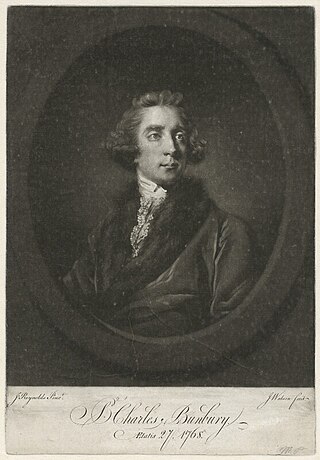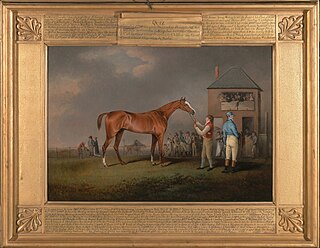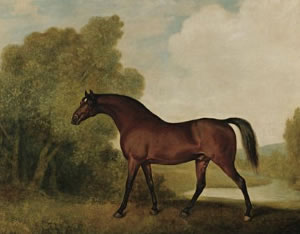Related Research Articles

Reveller was a British Thoroughbred racehorse and sire. His most significant win came in the 1818 St Leger Stakes, but he remained in training until 1823, winning numerous races in the North of England. He had a long rivalry with another northern champion, Doctor Syntax.

Smolensko was a Thoroughbred racehorse that won the 1813 Epsom Derby and 2,000 Guineas Stakes. Smolensko raced for two years and was retired to stud in 1815. He stood for seven years for his breeder, Charles Bunbury, and spent the remainder of his stud career in Surrey and Suffolk. Before his death at age 19 in 1829, he sired the filly Gulnare and the colt Jerry.

Phantom was a British Thoroughbred racehorse and sire. In a career that lasted from April 1811 to April 1813 he ran ten times and won seven races. In the summer of 1811 he proved himself one of the best British colts of his generation, winning the Derby on his second racecourse appearance. He continued to race with considerable success for two more years, mainly in match races. He was retired to stud in 1814 and became a successful sire of winners before being exported to Mecklenburg in 1832.
Zeal was a British Thoroughbred racehorse and broodmare, which won the eighth running of the classic 1000 Guineas. As a three-year-old in 1821 won she won her first three races at Newmarket Racecourse including the 1000 Guineas but then finished fourth in The Oaks. As a four-year-old she walked over in the valuable Port Stakes but was beaten in her only other race. She later had a successful career as a broodmare.

Cobweb (1821–1848) was an undefeated British Thoroughbred racehorse and who won two British Classic Races as a three-year-old and went on to become a highly successful broodmare. Cobweb's racing career consisted of three competitive races in the early part of 1824. After winning on her debut she claimed a second prize when her opponents were withdrawn by their owners. She then won the 1000 Guineas at Newmarket Racecourse and the Oaks Stakes at Epsom Downs Racecourse before being retired to stud.

Medora (1811–1835) was a British Thoroughbred racehorse and broodmare who won the classic Oaks Stakes at Epsom Downs Racecourse in 1814. In a racing career which lasted from April 1814 to May 1816, she ran thirteen times, won four races, and twice "received forfeit" when her opponent did not appear for a scheduled match race. Unraced as a two-year-old, Medora produced her best form in the first half of 1814, she finished third in the inaugural 1000 Guineas, won the Oaks and then claimed two races at Royal Ascot. She remained in training for two more seasons but was less successful, winning only one competitive race. She was retired to stud where she became a highly successful and influential broodmare, whose direct descendants won many major races throughout the 19th and 20th centuries.

Wizard was a British Thoroughbred racehorse. He won seven of his ten races, with all his wins coming at Newmarket. In 1809 he won the 2000 Guineas Stakes, before finishing second in the Derby Stakes. The following year he won a match race against his Derby conqueror Pope. Throughout his racing career he was owned by Christopher Wilson and trained by Tom Perren. Wizard only stood as a stallion for two years before dying in an accident in 1813. His son Young Wizard won the Riddlesworth Stakes and was the runner-up in the Derby in 1817.

Young Giantess (1790–1811) was a British Thoroughbred racehorse and broodmare. She failed to win any of the five races she contested, but became a successful broodmare for Sir Charles Bunbury. She foaled the successful sire Sorcerer and Derby and Oaks winner Eleanor.

Soothsayer (1808–1827) was a British Thoroughbred racehorse and sire best known for winning the classic St Leger Stakes in 1811. Bred and originally trained in Yorkshire he won the St Leger on his third racecourse appearance when still unnamed. He was later sold and trained for the remainder of his racing career at Newmarket where he won a valuable sweepstakes in 1812 and a match race against the Derby winner Phantom in 1813. He later became a successful breeding stallion, siring two classic winners and being the Leading sire in Great Britain and Ireland in 1819. He was later exported to Russia where he died in 1827.
William was a British Thoroughbred racehorse best known for winning the classic St Leger Stakes in 1814. In a racing career which lasted from May 1813 until May 1815 he contested eight races and won four times. After winning his last two starts as a two-year-old, he fell on his first appearance of 1814 and was beaten in his next race before winning the St Leger at odds of 7/1. He was beaten in his only race as a four-year-old and was sold and gelded before returning for two unsuccessful efforts in 1817.
Octavian (1807–1833) was a British Thoroughbred racehorse and sire best known for winning the classic St Leger Stakes in 1810. Despite suffering from hoof problems he was beaten only twice in a nine race career which lasted from April 1810 until September 1812, and which was conducted entirely in Yorkshire. Apart from his classic success, his most important win came in 1812, when he won a division of the Great Subscription Purse at York. He was retired to stud, where he had an early success by siring the St Leger winner Antonio, but his subsequent record was disappointing. Octavian died in 1833 at the age of twenty-six.
Ashton was a British Thoroughbred racehorse and sire best known for winning the classic St Leger Stakes in 1809. He was undefeated in three races as a three-year-old in 1809, culminating with his classic victory at Doncaster. After missing the whole of the 1810 season he won a Great Subscription Purse at York on his reappearance as a five-year-old but was beaten in his three remaining races. He was then retired to stud, where he had no success as a sire of winners.
Fyldener (1803–1829) was a British Thoroughbred racehorse and sire best known for winning the classic St Leger Stakes in 1806. In a racing career which lasted from June 1806 until June 1809 he won six times from ten competitive starts. As a three-year-old, Fyldener won his first four races, culminating with a win in the St Leger at Doncaster Racecourse. He failed to win in an abbreviated 1807 season and missed the whole of 1808, before returning as a six-year-old in 1809 to win his last two races. After his retirement from racing he had a long, but relatively undistinguished career as a breeding stallion.

Quiz (1798–1826) was a British Thoroughbred racehorse and sire best known for winning the classic St Leger Stakes in 1801. Quiz was a durable, top-class performer, winning at least once a year in racing career which lasted seven seasons from August 1801 until April 1807. Apart from the St Leger he won many other important races including three Brocket Hall Gold Cups, two Oatlands Stakes at Newmarket Racecourse, a Great Subscription Purse at York, a King's Plate and the Jockey Club Plate. In all he won twenty-one times in thirty-six races for four different owners before being retired to stud, one of which was Mr Hallett Esq, where he proved to be a successful sire of winners.

Symmetry was a British Thoroughbred racehorse and sire best known for winning the classic St Leger Stakes in 1798. Originally trained in Yorkshire won the St Leger at Doncaster on his final appearance as a three-year-old and went on to defeat The Derby winner Sir Harry in a match race at York in the following year. As a five-year-old he was transferred to race at Newmarket where he lost a rematch with Sir Harry, but won his three remaining races, including matches against Sorcerer and Diamond, two of the leading racehorses of the time. After his retirement from racing, Symmetry was sold and exported to stand as a breeding stallion in Russia.

Antonio (1816–1828) was a British Thoroughbred racehorse and sire best known for winning a controversial race for the classic St Leger Stakes in 1819. The classic was run twice after claims of an irregular start, but Antonio's victory in the original running was eventually allowed to stand. The rest of his racing career, which lasted from April 1819 until May 1822 was relatively undistinguished although he won five other races. After two minor successes in 1820 he missed the whole of the 1821 before returning as a six-year-old to win two races at Chester. He was then retired to stud where he had limited success as a sire of winners before his death in 1828.

St Patrick (1817–1843) was a British Thoroughbred racehorse and sire best known for winning the classic St Leger Stakes in 1820. He was unbeaten in four races as a three-year-old, culminating with a success against twenty-six opponents in the St Leger at Doncaster Racecourse. In the following year he won Gold Cups at York and Pontefract before being defeated in the Fitzwilliam Stakes at Doncaster. He was then retired to stud where he had some success as a sire of winners.

Ambrosio was a British Thoroughbred racehorse and sire best known for winning the classic St Leger Stakes in 1796. In a racing career which lasted from May 1796 until September 1799 he won fifteen of his twenty-three races. As a three-year-old he was based in Yorkshire, where he won his first three races before justifying his position as odds-on favourite for the St Leger, beating six opponents. In the next two years he competed mainly at Newmarket, where his victories three divisions of the Oatlands Stakes and the Jockey Club Plate. He returned to Yorkshire as a six-year-old to win a division of the Great Subscription Purse at York before being retired to stud. Ambrosio stood as a breeding stallion in Great Britain and Ireland, but had little success as a sire of winners.

Elis was a British Thoroughbred racehorse and sire best known for winning the classic St Leger Stakes in 1836. In a racing career which lasted from July 1835 until April 1837 he won eleven of his fifteen races. He finished second in his four defeats, two of which came when he was matched against the undefeated Bay Middleton. As a two-year-old he won five of his six races including the Chesterfield Stakes, Molecomb Stakes, Clearwell Stakes and Criterion Stakes. In 1836 he rebounded from a defeat by Bay Middleton in the 2000 Guineas to win Drawing-room Stakes, Racing Stakes, and Lewes Stakes in the summer. Elis was one of the first horses to be transported by horsebox and landed a major betting coup for his owners by winning the St Leger. He had limited impact as a sire of winners before being exported to Germany.
Hephestion was a British Thoroughbred racehorse and best known for winning the classic 2000 Guineas in 1810. The rest of his racing career was undistinguished, as he recorded only four other victories in minor contests from a total of eighteen competitive races. He does not appear to have found a place at stud as a breeding stallion.
References
- ↑ "Sorcerer". Tbheritage.com. Retrieved 2012-12-24.
- 1 2 The General stud book. Vol. 2. C, J, E and JP Weatherby. 1869. p. 80. Retrieved 2013-04-25.
- 1 2 "Throughbred Bloodlines - Mab - Family 9-d". Bloodlines.net. Retrieved 2013-04-25.
- ↑ Edward and James Weatherby (1814). Racing calendar. 1813. C H Reynell. p. 367. Retrieved 2013-04-25.
- ↑ Edward and James Weatherby (1811). Racing calendar. 1811. C H Reynell. p. 6. Retrieved 2013-04-25.
- ↑ Sporting magazine (1811). J Wheble. 1811. p. 348. Retrieved 2022-01-31.
- ↑ Edward and James Weatherby (1811). Racing calendar. 1811. C H Reynell. p. 18. Retrieved 2013-04-25.
- ↑ Sporting magazine (1811). J Wheble. 1811. p. 349. Retrieved 2013-04-25.
- ↑ Edward and James Weatherby (1811). Racing calendar. 1811. C H Reynell. p. 20. Retrieved 2013-04-25.
- ↑ Edward and James Weatherby (1811). Racing calendar. 1811. C H Reynell. p. 194. Retrieved 2013-04-25.
- ↑ Edward and James Weatherby (1813). Racing calendar. 1812. C H Reynell. p. 142. Retrieved 2013-04-25.
- ↑ Edward and James Weatherby (1813). Racing calendar. 1812. C H Reynell. p. 170. Retrieved 2013-04-25.
- ↑ "Trophonius pedigree". equineline.com. 2012-05-08. Retrieved 2013-04-25.